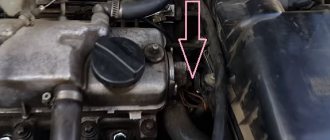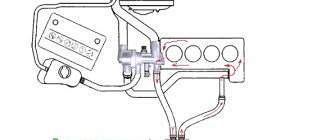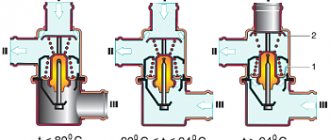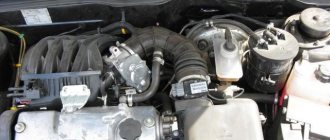Thermostat operating principle
The main purpose of the device is to slow down the flow of coolant into the internal combustion engine. By blocking the coolant flow, the engine warms up to operating temperature. As soon as the temperature mark reaches the operating norm, the VAZ 2114 thermostat opens.
On the side that is closer to the internal combustion engine, there is a special wax ball. The waxy material was chosen for a reason, because when heated it transforms from a solid into a liquid. And as soon as the wax begins to transform at a temperature above 83 degrees, it pushes out the pin, which is located in the cylinder. At this time, the valve opens and coolant begins to flow.
Replacing the thermostat VAZ 2110, 2114, 2107, 2109
Before you start replacing your thermostat, you can save a little money. In the summer, when the air temperature does not have a detrimental effect on the car engine, you can slightly “upgrade” the damaged thermostat and save the engine from overheating. If the valve does not open, the insides of the thermostat are completely pulled out, and it becomes the most common adapter for pipes. This option is perfect for those who do not yet have the opportunity to install a new part. The only disadvantage of this method is that it takes a long time to warm up the engine, especially if you are late for work. In winter, of course, this will be especially important.
Now about the replacement. The replacement procedure for a front-wheel drive car and a rear-wheel drive car is performed almost the same - the coolant is drained, the clamps are unscrewed and the old thermostat is removed. A new part is installed in its place. Now let's look at this video in detail for each of the cars.
VAZ 2107
If the radiator is an old model, then place any container of sufficiently large volume under it, disconnect the two wires from the temperature sensor located on the drain plug and unscrew the plug. In the new type of radiator, the sensor is located in a different place, so it will be enough to unscrew the special tap on the radiator. Wait until the coolant drains from the radiator and move the container under the engine. On the engine itself, unscrew the drain bolt and wait until the liquid drains from the engine. After this, unscrew the thermostat mounting clamps and pull out the pipes. The new thermostat at the connection points is lubricated with automotive sealant and mounted in place of the old one. Further assembly occurs in reverse order. Remember one thing - on a Zhiguli, first of all, antifreeze is poured into the radiator, and then into the expansion tank. This will help avoid unnecessary air pockets.
VAZ 2109
All the steps listed below are the same for the VAZ 2114 and VAZ 2110. As on the “seven”, we place the container under the radiator and unscrew the tap on it. The location of the tap may vary depending on the radiator brand. As soon as the liquid is drained, we move the container under the engine and begin to drain the antifreeze from the engine. Then, in the same way, unscrew the clamps securing the pipes to the thermostat and remove the latter. Don’t forget to also apply sealant to the joints and, after assembly, add coolant. This time, the liquid is poured only into the expansion tank.
That's all. That's all you need to know about the thermostat. Monitor the coolant temperature frequently and replace the faulty unit in a timely manner.
Symptoms of a problem
Thermostat malfunctions on the VAZ 2114 can be determined by external signs; for this there is no need to remove the device. Common symptoms that can help identify a malfunction:
- The instrument panel displays an elevated temperature at which the vehicle cannot be operated. The sensor shows a high temperature because the valves do not close/open. The device is in the closed position and does not allow coolant to flow, while the lower pipe is cool;
- The opposite problem occurs when the valve is open and because of this the pipe is constantly warm and begins to heat up a few minutes after starting the car.
- When the car is started, the thermostat needle shows incorrect values. For example, when the engine is running, it can drop sharply and show a temperature below normal, and when the car is turned off, its level can increase.
- The engine is constantly in an overheated state several minutes after starting.
When to change: signs of thermal switch failure
Abstract symptoms can indicate the nature of the disease that has befallen the thermostat:
Stuck in open position (coolant constantly circulates through radiator)
In cold weather, the engine does not heat up well, and at extreme city speeds the coolant temperature drops. Let's say it's -15°C outside, the coolant at idle has warmed up to 70°C, we're driving on a multi-lane road, moving at a speed of 60 km/h, and the temperature gauge needle is either standing still or going down.
Fuel consumption increases noticeably (+ 1-2 liters per 100 km). The wedge is in the closed position (antifreeze moves along the jacket and heater radiator, bypassing the main heat exchanger). There will be no cooling and overheating is inevitable in summer. The fact is clearly clarified by the thermometer needle running upward when the cooling fan is on. Additionally, the “brains” indicate a problem in the form of an illuminated Check Engine icon. Final stop at an intermediate position. Prolonged heating + overheating in hot weather. Slight increase in appetite (within 1 l/100 km).
It is impossible to close a large circle tightly, while the rod moves and the full opening occurs. There is no wedge. This is prevented by deposits accumulated as a result of untimely change of antifreeze, mixing coolant of different classes (for example, on a Hyundai Solaris, antifreeze can only be mixed with G11), and the use of cheap or counterfeit fluids. The fact can be revealed in warm weather only through tubes. In winter, pollution will be indicated by a reluctant rise in temperature from 70°C to 90-95°C when driving on the highway, but in the city there will be no problems with warming up. Seeing such a picture, those who like to cover the radiator grille with cardboard often persuade the owner to insulate the front end. This is definitely useful in cold weather.
Checking the device
There is a very simple way to check the VAZ 2114 thermostat for a malfunction without removing it from the car - this is to check the lower radiator pipe. If the engine remains cold when running, this indicates a clear problem. In this case, the VAZ 2114 thermostat does not need to be dismantled, and if it is cold, this indicates that the valve is jammed and does not open.
It is also possible to test the removed thermostat at home. To do this, you need to place it in a pan of water. The water gradually heats up, at a temperature of 82 degrees the valve begins to open. If this does not happen, then it is faulty and must be replaced.
One of the most popular causes of failure is the formation of corrosion, which is why the valve may stop opening. The issue can be solved simply simply by cleaning the device and bringing it into proper shape. Corrosion can be removed with acetone or gasoline. After the corrosion has been removed, you need to put the thermostat back in place and check its functionality.
How to check the thermostat on a VAZ 2113 - two ways
In order to check the thermostat on a VAZ 2113, you must perform the following steps:
- Take a pan with cold water, a thermometer up to at least one hundred degrees and a thermostat.
- We put it all on the tile to warm up and wait... We wait until the water temperature reaches 85 degrees.
- At this point we begin to look at the main thermostat valve. At 87 degrees it should open.
- If it does not open or opened earlier, then the thermostat is faulty.
There is another way to check the thermostat without removing it from the car. But for this, the car must be cold:
- After starting the engine, grab the lower pipe coming from the radiator with your hands.
- Until the temperature reaches 80 degrees it should be completely cold. When it reaches 85 degrees, the tube should begin to warm up slowly.
- And when 90 degrees is reached, full circulation of hot coolant should begin (i.e. the valve is completely open). The lower tube should be hot.
It happens that immediately after starting the engine, when it has warmed up only 50 degrees, warm liquid begins to flow through the lower tube. This shouldn't happen either!!! This means that the valve is constantly open.
Where is? How to replace a thermostat
Before replacing the thermostat, you must clear access to it. For VAZ 2114 1.5 and 1.6 on 8-valve engines, the process may be slightly different, but generally identical. After the functionality test has been carried out, we proceed to dismantling.
First of all, to get to the device we need to remove the air filter housing. To do this, unscrew the bolts, loosen the clamps and remove the chip from the MAF sensor.
The difference between the 1.5 engine is that when removing it there is no need for a wrench; on 1.6 engines there are fasteners that can only be unscrewed using a hexagon.
After this, prepare a container for the coolant and drain it. If the car is equipped with engine protection, then it must also be removed.
At the bottom of the radiator there is a special tap that allows you to drain the coolant. We place a container under it and unscrew it, waiting for the coolant to completely drain. In order for it to flow out faster, unscrew the cap on the expansion tank.
After the liquid has drained, the air filter housing has been removed, and the pipes have been disconnected, you can remove the thermostat.
Replacement of the device is carried out in the reverse order. Before installing a new device, it is necessary to clean the seat and thoroughly coat it with sealant.
After the thermostat is installed on the VAZ 2114 injector, we fix the pipes in the reverse order.
Replacing the thermostat
If during the inspection it was determined that the malfunctions of the VAZ 2114 thermostat are serious, and it can no longer be used (this especially applies to the situation when the device jams “in a small circle”), then it should be replaced.
It is produced as follows:
- Place the machine on the site.
- Open the hood and remove the negative terminal from the battery.
- Remove the air filter.
- Open the expansion tank cap.
- Remove the drain plug and drain all the coolant from the system into a prepared container.
- Loosen the clamps securing the cooling hoses leading to the thermostat.
- Unscrew all fasteners holding the thermostat housing.
- Remove the hoses from the thermostat and remove the device itself (this is best done by gently rocking its body).
- Remove the old gasket and clean the seat.
- Install a new gasket.
- Install a new thermostat, coat all pipes with sealant and connect the cooling system hoses to it (they should first be checked for damage and cracks and, if necessary, replaced with new ones).
- Secure the new thermostat housing using studs and nuts.
- Close the drain hole with a plug and pour new coolant into the system.
- Reinstall the air filter and start the engine.
Immediately after completing the replacement, you should check the functionality of the new thermostat by checking the condition of the radiator pipes (as explained above), and also make sure that hot air is discharged evenly from the radiator.
This will show that there are no air pockets in the cooling system, and the machine is completely ready for operation without the risk of overheating of the power unit.
Which thermostat is better to install on a VAZ
When replacing a thermostat, the question arises which one is best to choose. It all depends on the purpose of the purchase, as well as the service life.
Some of the most popular models are Gates and Vernet. They have proven themselves to be one of the best for a budget price. For the fourteenth VAZ for that kind of money it is a good option. The cost varies from 300 to 500 rubles.
Chinese analogues are devices that do not last long. They are usually bought by inexperienced drivers, or in case of a sudden breakdown in order to drive for a while and replace with a better model. They are practically the same in cost, the price range is from 350 to 450 rubles, but they are noticeably inferior in quality and you have to change them 2 times more often.
Original thermostats on VAZs are very unreliable, although there is an opinion that original parts last longer. But not for the fourteenth models; experienced drivers, if they have an original device, decide to replace it even before it breaks down, because they know that it will not last long.
Thermostat VAZ 2115: Replacement, check where it is located
A thermostat is a sensor designed to maintain a certain temperature. The thermostat blocks the path of antifreeze or any other coolant into the radiator until the engine reaches a certain operating temperature. The operating temperature of the engine is considered to be 90 degrees. The thermostat opens the coolant path at 95 degrees Celsius. Thanks to the thermostat, the engine spends less time warming up to operating temperature. It follows that the thermostat saves your pennies in your pocket and protects the environment. And it is located between the radiator and the engine.
Table of contents
Replacement How to check Which one is better to put Where is it located What does it look like
Replacement
First of all, you need to check whether the thermostat is really not working. We do the following:
1. start the car and feel the lower radiator pipe, it should be cold;
2. wait until the engine warms up to a temperature of 80-85 degrees and feel the pipe again, it should become warm.
Let's move on to the process of removing the thermostat. First, drain the coolant (you can only drain it from the radiator). Now loosen the hose clamps that are attached to the thermostat and remove them.
Then we remove the thermostat from the VAZ 2115.
To check if the thermostat is working, immerse it in water and start heating it; when the water temperature reaches 83-87 degrees, you should see the valve begin to open. If the valve stays still, the thermostat is faulty.
After installing the new thermostat, be sure to refill the coolant.
How to check
It is very easy to check the operation of the thermostat without removing it from the car. It is enough to start the cooled engine and check the temperature of the radiator pipes. In normal mode, when the engine is running, for some time after starting, only the upper radiator pipe will heat up slightly, and when the threshold value is reached, the lower pipe will also heat up sharply. This is evidence of normal valve operation. If heating of both radiator pipes begins simultaneously, this indicates that it is not functioning properly; most likely, the valve is constantly open.
The constantly open thermostat valve allows you to easily reach the nearest service station or spare parts store. It is much worse if the thermostat gets stuck closed, as there is a serious risk of engine overheating. Sometimes tapping on the thermostat body helps for a short time, but if the valve cannot budge, it should be removed or bent with a screwdriver. The thermostat must be replaced in the nearest locality.
Which one is better to put
It will also fit with 099 and 09, and with 083 and 093. It’s not a matter of VAZ models, the fact that components from one model fit another is a normal phenomenon for many manufacturers.
You need to buy a thermostat based on only a few things.
This is the metal from which the thermostat is made; preference should be given to stainless steel,
or brass and the second criterion is not to take Chinese spare parts under any circumstances, even if they are given away for free.
There is no option to check the thermostat while standing at the counter.
Many citizens begin to put pressure on the valve for some reason, apparently they want to check how the “spring” works, but there is no spring there, there is a special spiral made of a special material that operates only at a certain temperature.
If the seller has hot water, then lower the thermostat into the water and check the smooth movement of the rod.
Although, to be honest, it’s unlikely that the seller needs this.
Conclusion: pay attention to the metal first. Secondly to the country of manufacture, VAZ 2115 is a Russian car
Where is
It is located under the air filter housing on injection cars, but on carburetor Samara 2 (namely, the first VAZ 2115 were produced for a couple of years in a carburetor version), it is located exactly there, but the housing on them has simply been moved to a slightly different place, so it is no longer necessary on the carburetor It doesn’t take much trouble to remove the housing, but I just threw off the high-voltage wires and started working, but it doesn’t take long to remove the housing and on the injector it 100% needs to be removed to get to the thermostat, and after the housing is put aside, you will immediately see the thermostat is not armed it will even be visible to the eye (For clarity, it is indicated in the photo below with a red arrow) and next to it there is also a battery (indicated by a blue arrow) so that you understand 100% where it is and do not lose sight of it.
Replacement or repair
Of course, it is possible to repair a broken device, but is it really that effective? If you consider the repair option, it is recommended that it be carried out exclusively in the field if you have the necessary tools. If the valve is not working, you can try to clean it in order to get to your destination. After this, it is recommended to immediately replace it.
The thermostat on the VAZ 2114 is a consumable item, the cost of which is not so high to try to repair it. Purchasing a new device guarantees its long service life, while a refurbished device may break down after just a few days. Therefore, in the event of a breakdown, it is recommended to install an analogue, even within 500 rubles, which can definitely last at least six months to a year.
Replacing the VAZ 2114 thermostat, do it yourself
Before replacing your thermostat, purchase a new unit. Please note that savings in this matter may result in even greater costs. Valve problems can cause the engine to overheat and fail.
In such a situation, the costs will be much higher
This is why it is so important to buy a reliable thermostat for the VAZ 2114. Which is better? Here you should focus on the manufacturer and buy parts only in trusted stores or from a car dealer
Before starting work, prepare everything you need - sealant, a set of tools, a new device, a repair kit and new coolant. The algorithm of actions is as follows:
Drive into the pit (alternatively, you can use an overpass). If there is neither one nor the other, then you can work on a flat viewing platform.
Turn off the engine, raise the handbrake and make sure that the car engine has cooled down and the pipes are no longer hot. This is necessary primarily for safety.
Unscrew the drain valve at the bottom of the radiator and drain antifreeze or antifreeze into a pre-prepared container.
Note! It is highly not recommended to refill coolant even if you have recently replaced it. If you still use old liquid, let it settle thoroughly so that all the dirt settles to the bottom.
While the antifreeze or antifreeze is draining, unscrew the air filter, or rather its housing. To do this, just unscrew a couple of bolts and unscrew the clamp of the air duct pipe and pull out the connector from the mass air flow sensor (MAF). Field of which it can be dismantled.
Take a screwdriver and use it to loosen the main clamps on the pipes that go to the thermostat. Discard the pipes. Be careful when doing this - there may be some liquid left inside.
Using a hexagon, unscrew the three bolts that secure the thermostat and remove it along with the seal, as shown in the photo.
Thoroughly clean, wipe and lubricate the joint with sealant, install the O-ring and gasket.
Determining the functionality of the thermostat
In order to determine whether a given part works, you don’t even need to know where the thermostat is located. It is enough to simply warm up the engine, but do not bring its temperature to the red line. Then turn off the engine and open the hood, look for the upper and lower radiator hoses there. Simply touching them is enough. If one hose turns out to be hot, while the other remains cold, most likely the thermostat valve did not open when the engine was running, which means it is not operational and needs urgent replacement. The thermostat circuit is quite simple, the device is cheap, so there is no point in trying to repair it - changing it is much easier.
Thermostat malfunctions and their symptoms
Many car enthusiasts follow a path that seems simpler to them - they start looking for faults, not knowing what they might be. However, a car is a mechanism in which no matter what part you take, you will encounter a whole range of breakdowns. There is a similar problem with the thermostat. It has not just one malfunction, but five. It is proposed to begin diagnostics by studying them. Along the way, we will consider the consequences that should be expected in the event of a particular thermostat failure.
Fault 1. Thermostat is stuck open
As practice shows, valve jamming in the open position is the most common malfunction. It occurs for various reasons, all of which have the same outcome. Namely, the thermostat is constantly open, regardless of the coolant temperature. This means that antifreeze is always circulating in a large circuit.
As a result of the thermostat being stuck open, the following problems arise:
- the engine takes a long time to warm up in summer;
- in winter it doesn’t even reach operating temperature;
- the stove blows either slightly warm or completely cold air;
- the engine is unstable and not at full power;
- fuel consumption increases significantly;
- the lubricating properties and fluidity of engine oil are reduced;
- as a result, the wear of rubbing engine parts accelerates.
As a rule, car enthusiasts pay attention to this breakdown precisely in the winter season, when a stove is needed, but it does not heat. Although in fact, the cold in the cabin is not the most unpleasant consequence of this thermostat malfunction. Accelerated engine wear and increased fuel consumption are much more serious problems.
Fault 2. Thermostat is stuck in the closed position
This breakdown is less common than the first, but it is much more dangerous. When the thermostat valve is stuck in the closed position, coolant can only circulate through a small circuit, and access to the main radiator is cut off. As a result, the engine and stove normally reach operating temperature, but soon the antifreeze overheats and boils. Very high pressure is created in the system, and it eventually ruptures at its weakest point.
Unlike the first malfunction described, it will not be possible to operate a car for a long time with the thermostat stuck in the closed position. As soon as this happens, the engine will quickly reach operating temperature upon first start-up, and will immediately begin to overheat. If you do not pay attention to the coolant temperature gauge in a timely manner, then within a few minutes thick white steam will pour out from under the hood. It is possible that the engine will overheat to such an extent that the piston mechanism parts will jam, and then there will be even more problems.
The thermostat jamming in the closed position most often occurs for the same reason - the expanding composition flows out of the capsule, and the valve can no longer overcome the resistance of the spring. The valve disc may also become stuck in the thermostat housing. This happens after a very long period of inactivity of the car, but does not occur during regular use.
Fault 3: Thermostat opens and closes early
If the thermostat opens too early, coolant from the small circuit is dumped into the main radiator before reaching normal operating temperature. As a result, the engine never warms up completely. Accordingly, the defect is accompanied by poor operation of the stove, slightly increased fuel consumption, decreased throttle response and other problems described when considering the first malfunction.
Fortunately, this breakdown is very rare. Basically, when a non-original thermostat is installed in the cooling system the day before. The fact is that different engines have different optimal operating temperatures, and thermostats are developed in accordance with these indicators. As a result, if you put a non-original part on the car, the valve may open and close too early.
Fault 4. Thermostat opens and closes late
These defects are similar to the previous ones, but are more dangerous. If a thermostat that opens and closes early is simply an unheated engine, then if it operates late, the coolant may boil and destroy the system. The main radiator fan in this case, again, will not help in any way, since the hot liquid reaches the sensor that turns on the airflow late.
The manifestation of these malfunctions occurs for the same reason as in the previous case. The installed thermostat is designed to operate at other temperatures. However, one should not discount the possibility that the timing of the valve opening and closing has shifted due to wear. For example, if over time the spring that returns and holds the thermostat in the closed position weakens, then it will begin to open earlier than it should.
Malfunction 5. The thermostat does not open or close completely
The last common thermostat failure is when its valve, for one reason or another, cannot open or close completely. This malfunction is not as critical or dangerous as jamming in the closed position. But still, some unpleasant consequences will appear.
So, if the thermostat does not close completely, the large circuit is not completely cut off from the small circuit when the engine is cold or trying to reach operating temperature. Even such a seemingly insignificant defect is enough for the engine to warm up for a long time, and in winter it never reaches normal temperature. Again, the stove does not heat well, more fuel is consumed, the engine oil does not reach the required fluidity, and so on.
The second option, when the valve does not open completely, can be much more dangerous. The problem lies in the fact that under heavy load, the thermostat’s throughput is not enough to dump the overheated antifreeze into the radiator in the required volume for cooling. The result can be as sad as described in the case of the valve jamming in the closed position.
Methods for determining device malfunction
There are several ways to identify errors in the operation of the thermostat and eliminate the more serious consequences of its malfunction. For example, turn on the engine for a couple of minutes. If during this time the hose connecting the thermostat and the radiator manages to heat up, it means that there is a problem with the valve of the device. A hose of good design remains cold when the engine warms up briefly.
There are several ways to identify a thermostat malfunction, but it is best to seek help from a car mechanic.
There is another method to identify problems. The structure along with the thermometer is lowered into a special glass vessel with cold water. During the process of heating the water, it will become clear whether the unit is working properly or not. Sometimes a diagnostic scanner is used for such purposes.
To identify serious damage, it is recommended to seek help from specialists. They will help you resolve the problem in a timely and efficient manner.
Unit repair and replacement
Knowing why the thermostat does not work and what signs indicate its damage, you can begin repairs. If the breakdown is serious, the device is replaced with a new one. The new part must fully correspond to the failed structure. It is better to replace it when the engine has completely cooled down. In this case, you cannot do without special keys, sealant and a Phillips screwdriver.
You will need a 3-liter container. Cooled liquid will flow into it. Work on installing a new thermostat takes place in two stages: removing the damaged structure and installing a working device. The whole process will take at least 2 hours.
Removing the old part involves the following steps:
- Drain the cooled liquid into the prepared container.
- Removing the air filter.
- Unscrew the nut and 2 bolts from the inside of the engine compartment. After disconnecting, it is better to put these small parts in a visible place. This way they won't get lost.
- The connector is removed from the recirculation valve body, and the valve itself is removed along with the tubes.
- The connector is removed from the air flow sensor. The supply balloon is switched off.
- Then remove the filter.
- Using the existing keys, unscrew the nuts from the bottom and top of the thermostat. The structure is carefully pulled out of the nest.
Installing a new device involves performing all steps in reverse order. You can replace the structure yourself. Timely detection of malfunctions and repair of the thermostat improves the quality of vehicle operation.
Cold in summer is good. In winter, on the contrary, you want warmth, and more: both for the engine and for the interior. The problem cannot be solved without a thermostat, so they decided to introduce a thermal switch into the cooling system. The mechanism does not last forever, it serves as needed: some people take care of it for 40,000 km, others share their experience of trouble-free operation for 200,000 km. Failure will be marked by an undoubted violation of thermal equilibrium, and symptoms diagnosed at a time will indicate it.
Brief summary
Checking the thermostat using the described methods allows you to easily identify all its malfunctions and promptly replace the part with a working one. The test in boiling water also makes it possible to evaluate the performance of the new thermostat before installing it in the cooling system. After all, no one is safe from defective spare parts. In addition, using such a simple test, you can find out whether the valve operates at the desired temperature, and not earlier or late. This approach sometimes allows you to save money by installing a cheap analogue instead of the original thermostat.
Purpose and design features of the thermostat
The thermostat is designed to block the circulation of fluid through the cooling system until the car engine is completely warmed up in order to speed up this process and further maintain the required operating temperature.
Thermostat operating principle
is based on the melting of artificial wax placed in a small cylinder in the direction of the motor. Wax melts at a temperature of at least 80 degrees. At the same time, it expands, increasing in volume, due to which it squeezes the locking pin out of the cylinder, unlocking the thermostat valve and restoring circulation.
In general, a thermostat consists of:
- inlet pipe connected to the engine cooling system;
- bypass valve, which, if necessary, shuts off the small cooling circle;
- an outlet pipe connected to the coolant pump;
- spring holding the bypass valve;
- wax ball;
- inlet pipe connected to the radiator;
- springs holding the main valve;
- the main valve itself, designed to shut off the main circulation;
- piston;
- housings.
Before the engine warms up, the circulation of the coolant does not stop completely - it is carried out in a so-called small circle, where the coolant flows from the pump only through the cooling jacket and the heater radiator, so that the system does not stagnate. When the main circulation valve opens, the small circle is automatically closed.
That is, the entire thermostat device is actually just a cylinder, a return pin, wax and a number of minor parts. This simple thermostat circuit is effective and reliable, so it remains the same in most newer cars.
Causes of thermostat failure
The most important sign of a thermostat failure is a lack of circulation in the engine cooling system, which leads to overheating.
There can be many reasons why a thermostat may malfunction, but the most common problem is corrosion eating away at the cylinder and locking pin, causing fluid flow to not completely stop in any valve position.
In such a situation, it will be much more difficult for the engine to warm up, and it will take much longer than in normal mode. If, on the contrary, the thermostat constantly remains closed, the engine quickly overheats, which leads to a complete inability to continue driving or more serious consequences, such as thermal deformation of the cylinder block and expensive engine overhauls.
When the coolant temperature indicator is on the verge of overheating, despite the fact that one hose is hot and the other is cold, we can most likely say that the thermostat valve is stuck closed and the liquid is not passing through the radiator.
Machine operation when the thermostat is not working
If a car uses a non-working thermostat, this will lead to a decrease in the life of the internal combustion engine. It is easiest to eliminate the causes at the initial stages because it is a less expensive solution. In the later stages of operation, the driver has to treat the consequences and spend a lot more money.
When the thermostat is faulty in the small circle, circulation occurs in the large circle. Since the internal combustion engine warms up much longer, the oil does not have time to heat up during most of the work and acquire the optimal viscosity for the operation of the internal combustion engine.
If it is clear that the thermostat does not work in principle, then the engine will quickly heat up and exceed the normal temperature level. Overheating the engine reduces its operating time.
It is necessary to understand the consequences of operating a car and a non-functioning thermostat. And the breakdowns can be very serious - this is a breakdown of the internal combustion engine. At best, you will have to do a major overhaul, or at worst, look for a new engine. Of course, you can purchase a contract one from another car, but the cost is not budgetary, since the engine is the heart of the car.











